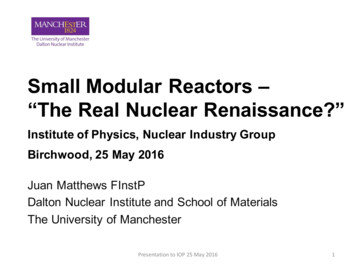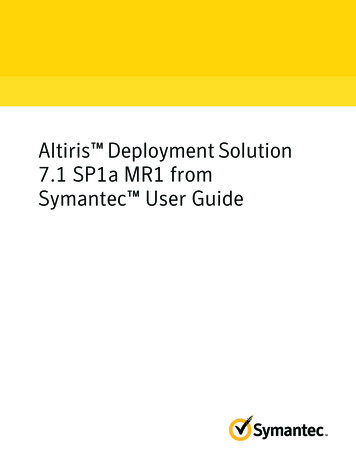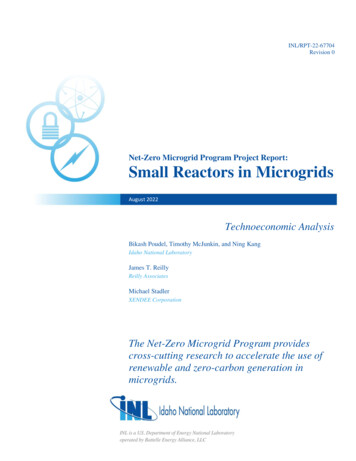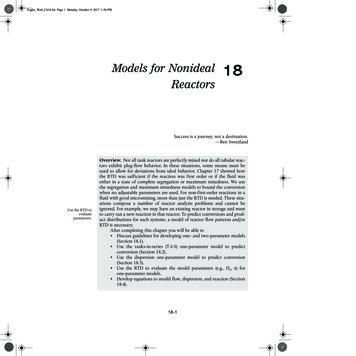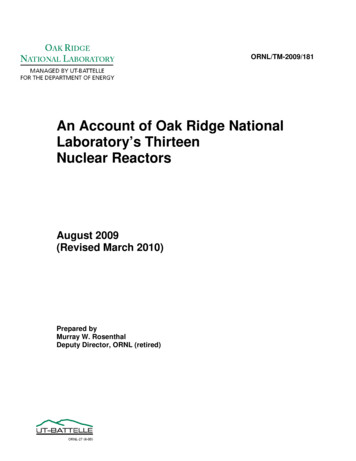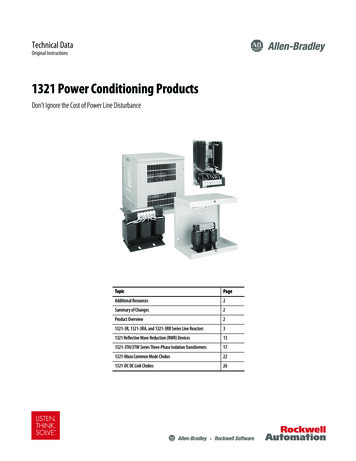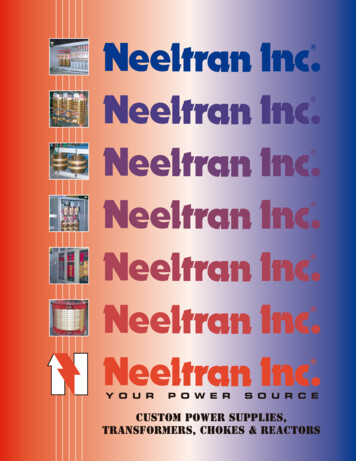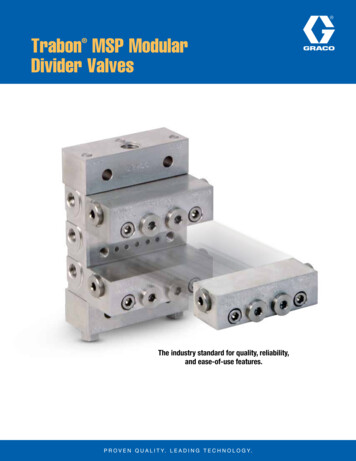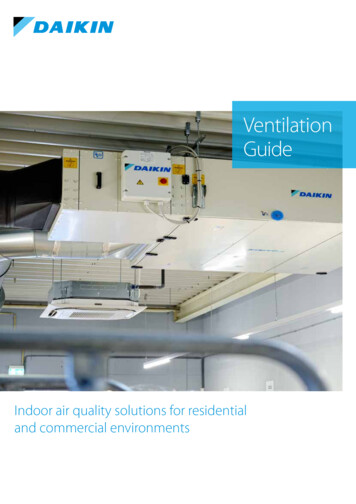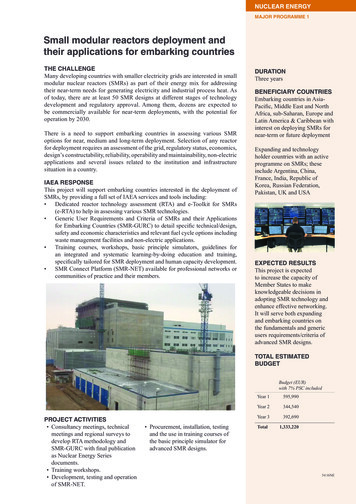
Transcription
NUCLEAR ENERGYMAJOR PROGRAMME 1Small modular reactors deployment andtheir applications for embarking countriesTHE CHALLENGEMany developing countries with smaller electricity grids are interested in smallmodular nuclear reactors (SMRs) as part of their energy mix for addressingtheir near-term needs for generating electricity and industrial process heat. Asof today, there are at least 50 SMR designs at different stages of technologydevelopment and regulatory approval. Among them, dozens are expected tobe commercially available for near-term deployments, with the potential foroperation by 2030.There is a need to support embarking countries in assessing various SMRoptions for near, medium and long-term deployment. Selection of any reactorfor deployment requires an assessment of the grid, regulatory status, economics,design’s constructability, reliability, operability and maintainability, non-electricapplications and several issues related to the institution and infrastructuresituation in a country.IAEA RESPONSEThis project will support embarking countries interested in the deployment ofSMRs, by providing a full set of IAEA services and tools including: Dedicated reactor technology assessment (RTA) and e-Toolkit for SMRs(e-RTA) to help in assessing various SMR technologies. Generic User Requirements and Criteria of SMRs and their Applicationsfor Embarking Countries (SMR-GURC) to detail specific technical/design,safety and economic characteristics and relevant fuel cycle options includingwaste management facilities and non-electric applications. Training courses, workshops, basic principle simulators, guidelines foran integrated and systematic learning-by-doing education and training,specifically tailored for SMR deployment and human capacity development. SMR Connect Platform (SMR-NET) available for professional networks orcommunities of practice and their members.DURATIONThree yearsBENEFICIARY COUNTRIESEmbarking countries in AsiaPacific, Middle East and NorthAfrica, sub-Saharan, Europe andLatin America & Caribbean withinterest on deploying SMRs fornear-term or future deploymentExpanding and technologyholder countries with an activeprogramme on SMRs; theseinclude Argentina, China,France, India, Republic ofKorea, Russian Federation,Pakistan, UK and USAEXPECTED RESULTSThis project is expectedto increase the capacity ofMember States to makeknowledgeable decisions inadopting SMR technology andenhance effective networking.It will serve both expandingand embarking countries onthe fundamentals and genericusers requirements/criteria ofadvanced SMR designs.TOTAL ESTIMATEDBUDGETBudget (EUR)with 7% PSC includedPROJECT ACTIVITIES Consultancy meetings, technicalmeetings and regional surveys todevelop RTA methodology andSMR-GURC with final publicationas Nuclear Energy Seriesdocuments. Training workshops. Development, testing and operationof SMR-NET. Procurement, installation, testingand the use in training courses ofthe basic principle simulator foradvanced SMR designs.Year 1595,990Year 2344,540Year 3392,690Total1,333,22054 16NE
NUCLEAR ENERGYMAJOR PROGRAMME 1Capacity building supportinglong-range sustainable nuclearenergy system planningTHE CHALLENGEA key challenge in the 21st century, as countries expanding their nuclearprogrammes are joined by those embarking on new nuclear programmes,will be to ensure that the global nuclear energy system continues to progresstowards sustainability.IAEA RESPONSEThe path to sustainable global nuclear energy systems requires innovativeapproaches in institutional arrangements and nuclear technology. Suchapproaches will be based on national, regional and global scientific technicalanalysis and will use broadly recognized metrics of sustainability. They willbe jointly developed by today’s and tomorrow’s nuclear energy users andtechnology developers.Multiple resolutions of the IAEA General Conference and the direction of theInternational Project on Innovative Nuclear Reactors and Fuel CyclesSteering Committee are shaping the IAEA’s response to this challenge. Theprimary objective is to continue assisting embarking and developing MemberStates in building capacity to conduct long-range nuclear energy systemplanning in a manner that promotes increasing nuclear sustainability.DURATIONFive yearsBENEFICIARY COUNTRIESIAEA Member States embarkingon or developing nuclearenergy programmesEXPECTED RESULTSThe project is expected toimprove communicationbetween experts from embarkingand expanding nuclear countriesand experienced counterpartsfrom technology holdingcountries. It will also improveresources and capacity in energysystem planning in embarkingand expanding countries.TOTAL ESTIMATEDBUDGETPROJECT ACTIVITIES International Project onInnovative Nuclear Reactors andFuel Cycles Dialogue Forums.These will be organized to helpadvance broad communicationon innovations and topicsrelated to global nuclear energysystem sustainability. Regional capacity buildingworkshops and training. Thesewill be held regionally, by distancelearning or in Vienna. Distance learning. To be providedto Member States’ education andYearBudget (EUR)with 7% PSC included2016489 0002017489 0002018489 0002019414 1002020344 500Total2 225 600technical institutions at the requestof the Member State. Long term planning assistance.Assistance will be provided toMember States in the applicationof the methodology assessment andanalysis tools of the InternationalProject on Innovative NuclearReactors and Fuel Cycles, tosupport long term planning efforts. Publication. A new edition of theInternational Project on InnovativeNuclear Reactors and Fuel Cyclesmethodology will be published.55 16NE
NUCLEAR ENERGYMAJOR PROGRAMME 1Plant life management in transitionfrom operation to decommissioningof nuclear power plantsTHE CHALLENGEFor nuclear power plants, the period of transition from operation todecommissioning is a critical one. Plant structures and components need toremain sound during this phase in order to safely contain residual radioactivity,and ageing management activities such as maintenance and inspections mustbe in place. At the same time, technical and organizational modifications areneeded to adapt the plant to meet new objectives. It is essential to provide owneroperators, contractors and regulators with guidelines for nuclear plant lifemanagement in the transition period, particularly in light of recently announceddecisions in some countries to permanently shut down operating reactors beforetheir licenses expire.IAEA RESPONSEAlthough various publications focus on management for the long-term operationof nuclear power plants, none deal specifically with the transition period fromoperation to decommissioning. This project aims to address that deficiency byhighlighting the technical, management and organizational issues arising duringtransition and providing guidance to minimize delays and undue costs. It alsoaims to provide guidance for optimizing personnel and other resources, andinitiating preparatory activities for decommissioning in a planned, timely andcost effective manner.DURATIONFour yearsBENEFICIARY COUNTRIESIAEA Member States expectedto transition from operation todecommissioning of nuclearpower reactors in the near futureEXPECTED RESULTSThis project will raise MemberStates’ awareness of goodpractices and lessons learned inthe transition from operationto decommissioning.TOTAL ESTIMATEDBUDGETYearPROJECT ACTIVITIES Analysis of programmerequirements. Three consultancymeetings and a technical meetingwill be held to develop a newNuclear Energy Series publication. Design and Development ofnew Nuclear Energy Seriespublication. This will focusBudget (EUR)with 7% PSC included201621 4002017107 0002018117 700201953 500Total299 600on plant life management forthe transition from operation todecommissioning of nuclearpower plants. Workshop/training course. Thiswill promote the dissemination ofinformation and knowledge relatedto the transition period.56 16NE
NUCLEAR ENERGYMAJOR PROGRAMME 1Quality and management systemaspects of nuclear procurementengineering and supply chainsTHE CHALLENGEThe nuclear supply chain has experienced a number of significant changes inrecent years. Increased globalization and a reduction in the number of traditionalnuclear suppliers have made sourcing of nuclear components more complex.Procurement-related issues have impacted nuclear power plant construction andoperation, making procurement engineering an increasingly important function.DURATIONThree yearsBENEFICIARY COUNTRIESIAEA Member States operating,expanding or constructingnuclear power plantsThere is a need to disseminate good practices and lessons learned in respect ofprocurement and supply chain challenges to owner operators, regulators, suppliers,auditors and other supply chain participants throughout the nuclear industry.IAEA RESPONSEThis project aims to inform Member States of good practices for the managementof procurement and supply chain activities related to the construction, operationand maintenance of nuclear facilities. They include aspects such as needsidentification, requirements development, value analysis, supplier research,negotiation, buying activities, establishing acceptance criteria, contractadministration, inventory control, transportation, receiving, warehousing,among others.EXPECTED RESULTSNewcomer Member States willbe able to train and developtheir staff using the onlinelearning module on procurementengineering. The project willalso enable Member Statesto develop or improve theirprocurement practices usingthe guidance documentson procurement.TOTAL ESTIMATEDBUDGETYearPROJECT ACTIVITIES Online learning module onprocurement and supply chainissues for nuclear facilities. To bepublished on the IAEA web site. Technical guidance document.This will focus on good practicesfor the management of supplychain vendors.Budget (EUR)with 7% PSC included201658 850201790 950201890 950Total240 750 Technical Meetings orinternational workshops.These will give Member Statesthe opportunity to provide relatedfeedback and experience forincorporation into IAEAguidance documents.57 16NE
NUCLEAR ENERGYMAJOR PROGRAMME 1Risk management of nuclear powerplant constructionTHE CHALLENGEFor countries expanding or constructing nuclear power plants, there is a needto identify and prioritize all relevant risks and to direct management strategiesaccordingly. The licensing preparation of nuclear power plants is drivenprimarily by upfront activities associated with construction, and each MemberState has a different mechanism for permission for construction and operation.IAEA RESPONSEAn integrated risk assessment approach is based on the understanding that allhealth and environmental risks should be systematically identified, analysedand assessed, and appropriately mitigated for nuclear power plant construction.DURATIONThree yearsBENEFICIARY COUNTRIESIAEA Member States withnew and expandingnuclear programmesThe project aims to develop a new practical guidance and referenceframework for undertaking such integrated health and environmental riskassessment studies for nuclear power plant construction. It will includethe licensing process, standardization, allocation of advanced technologyprogress and lessons learned. The integrated risk management approachalso necessitates the formulation of overall coordinated strategies involvingmulti-dimensional elements.PROJECT ACTIVITIES Analysis of programmerequirements. This will bethe focus of three consultancymeetings and a technical meeting. New Nuclear Energy Seriespublication. This will formulateintegrated risk managementstrategies, including theprioritization of implementationmeasures and resources, andan overview of organizationalrisk tolerance, capabilities,competencies and tools to manageidentified risks and licensing risks. Workshops and training. Thesewill promote the disseminationof technical content andlessons learned.EXPECTED RESULTSThe project is expected toenhance knowledge of theeffective and safe managementof nuclear power plant projectsfrom pre-project to the operationstage. It will help improvethe quality of preparation andsupervision of nuclear powerplants, including licensingprocesses, standardization,technology progress andlessons learned.TOTAL ESTIMATEDBUDGETYearBudget (EUR)with 7% PSC included201621 400201780 2502018101 650Total203 30058 16NE
NUCLEAR ENERGYMAJOR PROGRAMME 1Supporting the development ofmanagement systems and nuclear safetyculture in countries introducing nuclearpower programmesTHE CHALLENGELeadership and management are key ingredients for a safe, secure, peacefuland sustainable nuclear power programme. Major organizations involved innuclear power development are expected to have management systems in placeto ensure that they can define and implement the requirements for the safe andsecure operation of a nuclear power plant.DURATIONFive yearsBENEFICIARY COUNTRIESIAEA Member States buildingnuclear power infrastructuresIAEA Member States exploringthe nuclear power optionDuring the past five years, Integrated Nuclear Infrastructure Review missionsand other relevant missions consistently identified the need to further developleadership and management skills and competencies in newcomer countries. Asa result, many of these countries have asked for additional assistance in theseareas, as well as in establishing the safety culture necessary for the operatingorganizations and regulatory bodies.IAEA RESPONSEThis project aims to support the development of integrated managementsystems in newcomer countries in order to foster effective relationships betweenregulatory bodies and operating organizations. It will also promote greateraccess to the IAEA’s Safety Culture Continuous Improvement Process.EXPECTED RESULTSThe development of integratedmanagement systems innewcomer countries will helpbuild stronger leadership andmanagement skills in the seniorexecutives of future operatingorganizations and regulatorybodies. It will also promote amore sustainable and thoroughorganizational basis for thecontinuous improvement ofsafety culture in futureoperating organizationsand regulatory bodies.TOTAL ESTIMATEDBUDGETYearPROJECT ACTIVITIES Expert missions, upon the requestof Member States, to introduceintegrated management systems. Expert missions, upon the requestof Member States, to assessorganizational needs and developan action plan for implementation. Six-week workshop programme.Three in-depth modular workshopswill help train experts in newcomercountries on how to implementan integrated management systemwithin their organizations. Nuclear safety culture continuousimprovement process.Budget (EUR)with 7% PSC included2016513 6002017567 1002018567 1002019567 1002020567 100Total2 782 00059 16NE
NUCLEAR ENERGYMAJOR PROGRAMME 1Strengthening excellence in nuclearplant operationsTHE CHALLENGEMember States expanding or introducing nuclear power programmes needto strengthen the operational knowledge of personnel moving into middlemanagement roles at nuclear power plants. This is especially true for countrieswith smaller existing programmes and limited resources and expertise. Inparticular, there is often a lack of operations management education and trainingfor middle managers with significant safety responsibilities in the day-to-dayoperation of nuclear power plants.DURATIONFive yearsBENEFICIARY COUNTRIESIAEA Member States planning,constructing or operating nuclearpower plantsThe IAEA already facilitates a wide variety of programmes targeted at variousmanagement levels. Most of these activities, however, focus on generalmanagement and on programme and project responsibilities, but not onoperations management.IAEA RESPONSEThe objective of this project is to assist Member States in developing thecompetence of the next generation of nuclear power plant managers byproviding them with training related to concepts and practices, plus the toolsto improve their knowledge, skills, attitude and behaviour as it relates tooperational excellence.EXPECTED RESULTSThe main outcomes of thisproject will be increasedcompetence in safe nuclearpower plant operationsmanagement and in futureoperating organizations, withlonger term impact on theoperational excellence ofnuclear power plants. Theproject will also serve tobuild capacity in the area ofoperations management forparticipating countries.TOTAL ESTIMATEDBUDGETYearPROJECT ACTIVITIES Detailed analysis of programmerequirements. Two consultancymeetings will be held to facilitateplanning of the course content. Design and developtraining materials. Upgrades and acquisition of basicprinciple simulators. Optional e-learningpreparatory training. Three four-week-long trainingcourses. These will take place withvarious host organizations in threedifferent regions: Europe, Asiaand the Americas.Budget (EUR)with 7% PSC included201640 0002017360 0002018250 0002019200 0002020200 000Total1 050 00060 16NE
NUCLEAR ENERGYMAJOR PROGRAMME 1Strengthening nuclear powerinfrastructure development inMember StatesTHE CHALLENGECurrently more than 30 countries are considering, planning or constructing a firstnuclear power plant. The IAEA is often the first point of contact for these countries,and the document Milestones in the Development of a National Nuclear PowerProgramme and the Integrated Nuclear Infrastructure Review missions, alongwith other IAEA services, are widely used by these Member States.IAEA RESPONSEThis project aims to strengthen IAEA guidance to countries introducingnuclear power by incorporating the most recent international experience andlessons learned into the guidance. It will help encourage information sharingthrough workshops, conferences and other events. At the same time, the projectwill assist countries planning nuclear power to benefit from the IntegratedNuclear Infrastructure Review programme and receive recommendations andsuggestions to identify and fill gaps in their national infrastructure to supportnuclear power.PROJECT ACTIVITIES Strengthening the Milestonesapproach. This includesupdating and developing IAEAguidance documents and casestudies in topical areas of nuclearinfrastructure development. Integrated NuclearInfrastructure Review missionimplementation.This includes self-evaluationsupport missions and IntegratedNuclear Infrastructure Reviewmissions and pre-missions.The missions will be conductedupon the request of Member States. Workshops, conferences andother events. These aim topromote information sharing onnuclear power development. Guidance to newcomer countries.Guidance will be providedaccording to the developmentof their programme throughMilestones Workshops andIntegrated Work Plans.DURATIONFive yearsBENEFICIARY COUNTRIESIAEA Member States planningor constructing nuclearpower plantsEXPECTED RESULTSThe project is expected to resultin the continuous improvementof IAEA guidance by gatheringand distributing up-to-dateinternational experienceand views on infrastructuredevelopment. Results willalso include a standardizedIntegrated Nuclear InfrastructureReview programme, conductedeffectively and with adequatefollow-up. In addition, there willbe increased awareness of theintegrated and comprehensivenature of nuclear infrastructuredevelopment, as well as betterinformed decision making andplanning by governments andother stakeholders throughsharing of experience andlessons learned.TOTAL ESTIMATEDBUDGETYearBudget (EUR)with 7% PSC included2016470 8002017567 1002018492 2002019449 4002020331 700Total2 311 20061 16NE
NUCLEAR ENERGYMAJOR PROGRAMME 1Supporting the development of safetyinfrastructure for site selection andevaluation in Member StatesTHE CHALLENGESite selection and evaluation for nuclear power plants is a fundamental stepin infrastructure development for Member States embarking on new nuclearpower programmes. An appropriate process of site selection and evaluation cansubstantially impact public acceptance and the safety of the nuclear power plantover its operating lifetime.IAEA RESPONSEThe IAEA works with Member States to strengthen capacity with respect to sitesafety aspects, supporting informed decisions on future activities related to afirst nuclear power plant.The objectives of this project are to enhance technical competences on siteselection and evaluation through capacity building services. For MemberStates embarking on a nuclear power plant programme, it will provide Siteand External Events Evaluation missions, as well as advisory services to assistMember States in selecting and evaluating suitable sites in accordance withinternational standards and updated methodologies, criteria and engineeringpractices. In addition, the project aims to increase the dissemination of lessonslearned from past external events and best international practices on siteselection and evaluation.DURATIONFive yearsBENEFICIARY COUNTRIESIAEA Member States developingnuclear power infrastructuresor exploring the nuclearpower optionEXPECTED RESULTSThe development of a set ofonline learning modules and theimplementation of awarenessworkshops will complementcapacity building services onsite selection and site evaluation.Advisory services will enhancethe technical capabilities ofMember State stakeholders inthe review of site permitlicense applications.TOTAL ESTIMATEDBUDGETYearPROJECT ACTIVITIES Developing online trainingmodules on capacity building forsiting nuclear power plants. Site and External EventsEvaluation missions. Thesewill be implemented in countriesembarking on nuclear power plantprogrammes and upon the MemberStates request. Advisory services. Available forembarking countries to confirmachievement of conditions forPhases 1 and/or 2, in accordancewith the publication Milestonesin Development of a NationalInfrastructure for Nuclear Power.Budget (EUR)with 7% PSC included2016361 1252017361 1252018321 0002019294 2502020294 250Total1 631 75062 16NE
NUCLEAR ENERGYMAJOR PROGRAMME 1Enhancing understanding of reactorphysics and technology through the useof basic principle simulators to supportcapacity buildingTHE CHALLENGEThere is increasing interest in training aids for nuclear newcomer countriesas they prepare to tackle the significant challenges associated with assessingreactor technologies, planning for their first nuclear power plant and educatingtheir nuclear professionals. Basic reactor simulators provide insight andunderstanding into the design, operational characteristics, key safety systems,and transient/accident behaviour of various types of reactors. The IAEA providesa suite of eight simulators to Member States, but there is a need to upgrade fiveof them, so that they can run properly on an advanced operating system.DURATIONThree yearsBENEFICIARY COUNTRIESIAEA Member Statesintroducing or interested inexpanding their nuclearpower programmesIAEA RESPONSEThis project aims to develop and upgrade five simulators to allow theirmigration into current Windows operating systems. It will also develop a trainthe trainer course for understanding reactor plant fundamentals through the useof simulators and host several such training courses.EXPECTED RESULTSThe continuing functionality offive basic principle simulatorswill support human capacitybuilding by Member States.The development of a trainthe trainer programme for useof the simulators to teach thefundamentals of water-cooledreactor physics and technologywill primarily benefitnewcomer countries.PROJECT ACTIVITIES Develop and upgrade fivesimulators representing differentreactor technologies. This includesrevising and updating softwarepackages and migrating theupdated simulators into Windows10 operating system. Develop a train the trainercourse. A consultancy meeting willbe organized to plan and develop anew training course curriculum. Conduct three train the trainercourses. At least one trainingcourse will be organized each yearof the three-year project. Lessonslearned from the first trainingcourse will be incorporated intosubsequent courses.TOTAL ESTIMATEDBUDGETYearBudget (EUR)with 7% PSC included2016299 600201785 600201885 600Total470 80063 16NE
NUCLEAR ENERGYMAJOR PROGRAMME 1Advances in the uraniumproduction cycleTHE CHALLENGEDemand for uranium remains strong, driving exploration for and identificationof new resources across the globe. With this ongoing activity comes a renewedneed for technological advancement and responsible mining, as well as prudentmanagement of facilities.IAEA RESPONSETwo priority areas have been identified in which Member States need support.The Advanced Technologies for Uranium Production activity includes supportin business case development, scoping and pre-feasibility studies, planning anddesign, operations, mine closure and end of life. The Essential Environmentaland Social Aspects of the Full Uranium Production Cycle activity involvestechnical or training meetings in Member States with past, current or plannedactivities in the uranium production cycle.PROJECT ACTIVITIES Develop and deliver. Innovativetechnology development trainingand associated materials to bedeveloped and delivered forsustainable uranium projectdevelopment and management. Deliver a project feasibility studytemplate and guidelines. Theseare to be applicable for “smart”comprehensive extraction projects. Disseminate information.Promote the dissemination ofcurrent and practical informationon the essential environmental andsocial aspects of the full uraniumproduction cycle. Publish. Collected written paperswith an expert-written overviewof the project activities andapplicability for the instruction ofnewcomer countries’ personnel tobe prepared for publication.DURATIONFour yearsBENEFICIARY COUNTRIESIAEA Member States currentlyactive in uranium mining, thoseplanning to start uranium miningand those who have legacyuranium mining sitesEXPECTED RESULTSThe project will facilitate andsupport transition from thecurrent traditional uraniummining and processing approachto a transformative “smart”model, in line with the UNSustainable DevelopmentGoals. It will also contribute toimproving the environmental andsocial performance of uraniumproduction cycle facilities andreducing the risk of futurelegacy sites.TOTAL ESTIMATEDBUDGETYearBudget (EUR)with 7% PSC included2016124 1202017124 1202018124 1202019140 170Total512 53064 16NE
NUCLEAR ENERGYMAJOR PROGRAMME 1Support to the IAEA Service of IntegratedResearch Reactor InfrastructureAssessment (IRRIA) missionsTHE CHALLENGEInterest in developing research reactor programmes has grown significantly inrecent years, with several Member States currently at different stages of newprojects. The majority of these countries are building their first research reactoras a key national installation for the development of their nuclear science andtechnology programmes.IAEA RESPONSEThe IAEA supports Members States in such efforts. To continue facilitatingthe successful development of new research reactors, IAEA IntegratedResearch Reactor Infrastructure Assessment (IRRIA) missions help MemberStates to determine their nuclear infrastructure status and identify gaps anddevelopment needs.DURATIONFour yearsBENEFICIARY COUNTRIESIAEA Member Statesconsidering and implementingnew research reactor projectsSuch a mission is intended to build upon Member States’ self-evaluation todetermine areas where additional work would be beneficial and to identifyfurther actions and assistance, including from the IAEA.PROJECT ACTIVITIES Initial mission. Following aMember State’s self-assessment,an initial mission will reviewthe overall situation in thecountry regarding infrastructuredevelopment activities, asdescribed in the publicationResearch Reactor Milestones. Allthe missions are conducted uponthe Member States’ request. Follow-up mission. This will focuson the response to the previousmission’s recommendations andsuggestions, as well as on theactivities accomplished. Prior to invitation for bids forthe first/new research reactor.This mission is implemented whenthe Member State is ready to invitebids for the research reactor.EXPECTED RESULTSThe main output of an IntegratedResearch Reactor InfrastructureAssessment mission is a finalreport that summarizes itsresults, including a descriptionof the mission’s objectivesand scope, areas reviewedand activities conducted,identified strengths and areasfor improvement. Otherobservations that the teamfeels need to be highlightedto the requesting MemberState, recommendations andsuggestions for planning futureactivities are also included.TOTAL ESTIMATEDBUDGETYearBudget (EUR)with 7% PSC included2016117 7002017117 7002018117 7002019117 700Total470 80065 16NE
NUCLEAR ENERGYMAJOR PROGRAMME 1Support to the IAEA Service ofOperational and MaintenanceAssessment of Research Reactors(OMARR) missionTHE CHALLENGEAs research reactors age, their proper operation and maintenance becomes evermore important. Many Member States look to the IAEA for advice, support andinformation exchange in this area.IAEA RESPONSEThe main objective of an Operational and Maintenance Assessment of ResearchReactors (OMARR) mission is to conduct a comprehensive operation andmaintenance review of the research reactor facility, suggest areas of improvementand potential solutions, identify good practices, and as appropriate share lessonswith research reactor communities. Its recommendations can also be used todisseminate implementation practices within the research reactor community,with the agreement of the recipient operating organization.DURATIONThree yearsBENEFICIARY COUNTRIESIAEA Member States operatingresearch reactorsEXPECTED RESULTSAn official mission report will beproduced in Vienna by the teamleader and sent to the researchreactor operating organization,with a copy to the Governmentof the host Member State. It willinclude good practices as well asissues for the Member State toaddress in order to improve theoperation and maintenance ofresearch reactors.Such a mission will alsoc
(e-RTA) to help in assessing various SMR technologies. Generic User Requirements and Criteria of SMRs and their Applications for Embarking Countries (SMR-GURC) to detail specific technical/design, safety and economic characteristics and relevant fuel cycle options including waste management facilities and non-electric applications.
